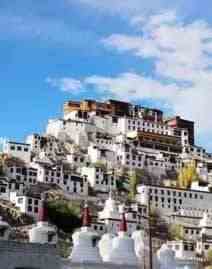Make sure to include some of Ladakh's well-known monasteries, palaces, and the old town of Leh when you browse trip packages.
Much of Ladakh, which runs from the Himalayas into the Kunlun Ranges and includes the productive upper Indus River valley, is over 9800 feet in elevation and has been suggested as a Union Territory (at the time of writing). The plateau of Ladakh is now bordered by Tibet to the east, the valley of Jammu and Kashmir to the west, Lahaul and Spiti to the south, and the Karakoram Pass of the Himalayas to the far north. These are the current borders.
It should come as no surprise that Ladakh changed into a region of rocky, barren peaks with gorgeous gompas (Buddhist monasteries) perched precariously on them. The primary-colored prayer flags that are flapping nearby only serve to emphasise how starkly white stupas stand out in contrast. The prayer wheel produces chants that blend with the wind as it moves and create a tune that is both peaceful and eerie as it is turned clockwise.
The interior of the gompas, where the red-robed monks reside, is a bright contrast to the bleak, ochre and drab terrain outside. Ladakh is a bit of Tibet lost in time, painted in a riot of colour with elaborate murals and vibrant, golden-hued Buddhas.
Ladakh's economy offers some valuable lessons to the world's more developed commercial economies despite being far from cash-rich. A typical Ladakhi is self-sufficient for the tsampa or roast barley flour, the dairy (yak's milk, cream, and cheese), and the chhang or barley beer that he locally produces despite living in rural mud-brick dwellings.
Ladakh holiday packages,budget holiday packages
Ladakh Family Packages:

Best Of Ladakh...
Best Of Ladakh Special Package
5 Night & 6 Days l Package
leh(Hotel) 5N,Nubra 1N
5 Night & 6 Days l Package
leh(Hotel) 5N,Nubra 1N

Explore Monasteries Of ...
Explore Monasteries Of Ladakh Special Package
6 Night & 7 Days l Package
Leh(Hotel) 4 Nights.. + Nubra 1N → Pangong 1N
6 Night & 7 Days l Package
Leh(Hotel) 4 Nights.. + Nubra 1N → Pangong 1N

Enchanting Ladakh...
Enchanting Ladakh Special Package
7 Night & 8 Days l Package
Leh(Hotel) 5N.. + Nubra 1N → Pangong 1N
7 Night & 8 Days l Package
Leh(Hotel) 5N.. + Nubra 1N → Pangong 1N

Majestic Ladakh Tour...
Majestic Ladakh Tour From Srinagar Special Package
8 Night & 9 Days l Package
Srinagar(Hotel) 1N.. + Sonmarg 2N → Kargil 1N → Leh 4N → Nubra 1N → Leh 1N
8 Night & 9 Days l Package
Srinagar(Hotel) 1N.. + Sonmarg 2N → Kargil 1N → Leh 4N → Nubra 1N → Leh 1N